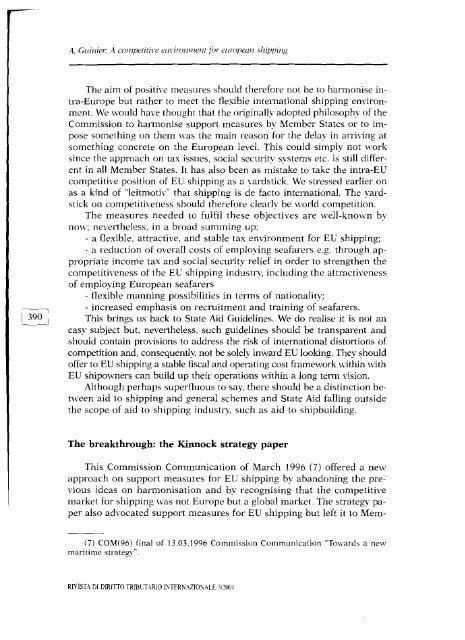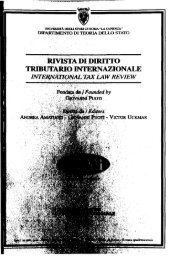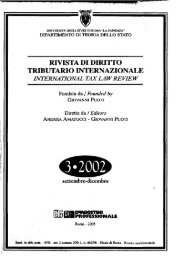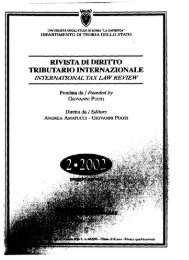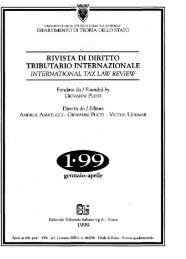RIVISTA DI DIRITTO TRIBUTARIO INTERNAZIONALE - Rdti.it
RIVISTA DI DIRITTO TRIBUTARIO INTERNAZIONALE - Rdti.it
RIVISTA DI DIRITTO TRIBUTARIO INTERNAZIONALE - Rdti.it
You also want an ePaper? Increase the reach of your titles
YUMPU automatically turns print PDFs into web optimized ePapers that Google loves.
A. GlIì17ier: A cOlllpel<strong>it</strong>il 'e ellt'irOl1ll1elll lò" europea Il shippi17g<br />
The aim of pos<strong>it</strong>ive measures should therefore not be to hannonise inlra-Europe<br />
but rather lo meet the f1exible intemalional shipping environment.<br />
We \Vould have thought lhal lhe originali\" adoPled philosophv of lhe<br />
Commission to hmmonise support measurcs by Member States or to impose<br />
something on them was the main reason for the delay in ani\ing at<br />
something concrele on the European leve/. This could simply not \l'ork<br />
since the approach on tax issues, social secur<strong>it</strong>y systems etc. is still differenl<br />
in ali Member States. Il has also been as mislake lo take the intra-EU<br />
compet<strong>it</strong>ive pos<strong>it</strong>ion of EU shipping as a :yardstick. y.,.re stressed earlier on<br />
as a kind of "Ie<strong>it</strong>moti\'" that shipping is de faclo intemationa/. The vardslick<br />
on compet<strong>it</strong>iveness should therefore clearlv be \l'orld compet<strong>it</strong>ion.<br />
The measures needed lO fulfil lhese objectiv'es are well-known bv<br />
now; nevertheless, in a broad summing up:<br />
- a l1exible, attractiv'e, and stable tax environment for EU shipping;<br />
- a reduction of overall costs of employing seafarers e.g. through appropriate<br />
income tax and social secur<strong>it</strong>y relief in order to strengthen the<br />
compel<strong>it</strong>iveness of the EU shipping industr\", including the attractiveness<br />
of employing European seafarers<br />
- flexible manning possibili ti es in terms of national<strong>it</strong>y;<br />
- increased emphasis on recru<strong>it</strong>ment and training of seafarers.<br />
This brings us back to Stale Aid Guidelines. We do realise <strong>it</strong> is noI an<br />
easy subject but, nevertheless, such guidelines should be lransparent and<br />
should contain prm;sions to address the risk of inlemational distortions of<br />
competilion and, consequently, noI be solely inward EU looking. They should<br />
offer to EU shipping a stable fiscal and operaling cost framework w<strong>it</strong>run w<strong>it</strong>h<br />
EU shipo\\TIers can build up their operations \v<strong>it</strong>hin a long tenn vision.<br />
Although perhaps superfluous to say, there should be a distinction bet",een<br />
aid lo shipping and generaI schemes and State Aid falling outside<br />
the scope of aid to shipping industry, such as aid to shipbuilding.<br />
The breakthrough: the Kinnock strategy paper<br />
This Commission Communicalion of March 1996 (7) offered a ne\\'<br />
approach on support measures for EU shipping by abandoning the previous<br />
ideas 00 harmonisatioo aod by recognisiog that the compet<strong>it</strong>ive<br />
markel for shipping \Vas noI Europe but a global market. The strategy paper<br />
also advocated support measures for EU shipping but left <strong>it</strong> lo Mem-<br />
(7) COM(96) final of 13.03.1996 Commission Communication "Towards a ne\-\'<br />
mar<strong>it</strong>ime strategy".<br />
RIYISTA <strong>DI</strong> <strong>DI</strong>RllTO TRIBL"T:\RIO riTERNAZfO'\,ALE 3COOl


